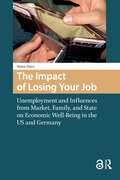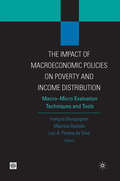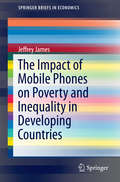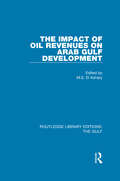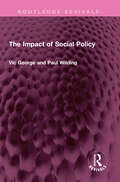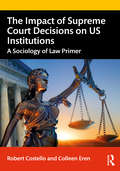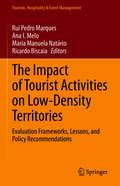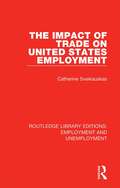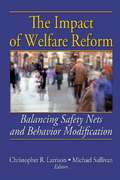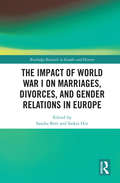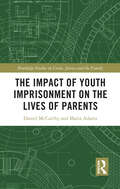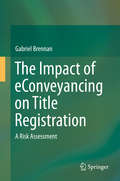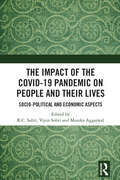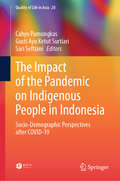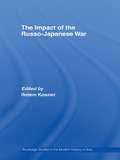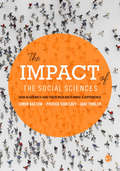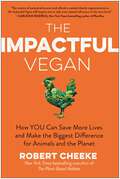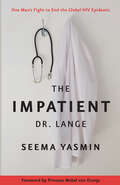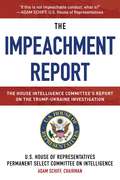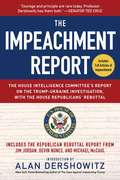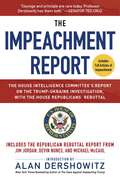- Table View
- List View
The Impact of International Migration
by Lira SagynbekovaThis book comprisesthe historical overview of migration processes in Kyrgyzstan, contemporarymigration trends in international migration and various social, economic andpolitical impacts of migration. It presents the findings of longstanding,in-depth, comprehensive and empirical research. Insights are maximized by applyingthe multi-sited strategy of analyzing both the migrant's place of origin andthat of destination. The primary goal of the book is to contribute to a betterunderstanding of the meanings and the impacts of contemporary internationalmigration processes in Kyrgyzstan and their relevance for local livelihoods.
The Impact of Losing Your Job: Unemployment and Influences from Market, Family, and State on Economic Well-Being in the US and Germany (Changing Welfare States)
by Martin EhlertLosing a job has always been understood as one of the most important causes of downward social mobility in modern societies. And it's only gotten worse in recent years, as the weakening position of workers has made re-entering the labour market even tougher. The Impact of Losing Your Job builds on findings from life course sociology to show clearly just what effects job loss has on income, family life, and future prospects. Key to Ehlert's analysis is a comparative look at the United States and Germany that enables him to show how different approaches to welfare state policies can ameliorate the effects of job loss-but can at the same time make labour insecurity more common.
The Impact of MacroEconomic Policies on Poverty and Income Distribution
by François Bourguignon Maurizio Bussolo Luiz A. Pereira da SilvaA companion to the bestseller, The Impact of Economic Policies on Poverty and Income Distribution, this title deals with theoretical challenges and cutting-edge macro-micro linkage models. The authors compare the predictive and analytical power of various macro-micro linkage techniques using the traditional RHG approach as a benchmark to evaluate standard policies, such as a typical stabilization package and a typical structural reform policy.
The Impact of Mobile Phones on Poverty and Inequality in Developing Countries
by Jeffrey JamesThis book investigates at both the micro- and macroeconomic levels the impact of mobile phones on poverty and inequality in developing countries. To gauge the effects of mobile phones on these aspects, the author refers to the standard concept of technology adoption and also analyses the actual utilization of mobile phones as a means of communication and the degree to which they have supplanted fixed-line phones. Readers will learn why the substitution effect is stronger among poor than rich users and why the benefits of some mobile phone projects are confined to the local or village level, while in other projects the gains can be felt throughout the economy as a whole.
The Impact of Oil Revenues on Arab Gulf Development
by M.S. EL AZHARYAs the price of oil fell in the eighties the pressures on the Arab Gulf States to speed up the diversification of their economies into non-oil sectors increased. This book, first published in 1984, examines this problem and many other issues connected with the impact of oil revenues on development in the Gulf States. It considers changing oil production policies and developments in other sectors of the economy including agriculture, industry and banking. It explores population problems, moves towards Gulf economic coordination and the impact of oil on society, culture and education. This book provides an assessment of just how much the region depends on oil for its economic prosperity and development and some indication of the enormous problems that would face the region should the demand for oil decease still further.
The Impact of Racism on African American Families: Literature as Social Science
by Paul C. RosenblattIn spite of the existence of statistics and numerical data on various aspects of African American life, including housing, earnings, assets, unemployment, household violence, teen pregnancy and encounters with the criminal justice system, social science literature on how racism affects the everyday interactions of African American families is limited. How does racism come home to and affect African American families? If a father in an African American family is denied employment on the basis of his race or a wife is demeaned at work by racist slurs, how is their family life affected? Given the lack of social science literature responding to these questions, this volume turns to an alternative source in order to address them: literature. Engaging with novels written by African American authors, it explores their rich depictions of African American family life, showing how these can contribute to our sociological knowledge and making the case for the novel as an object and source of social research. As such, it will appeal to scholars and students of the sociology of the family, race and ethnicity, cultural studies and literature.
The Impact of Religion, Personality, Values and Worldviews on Attitudes Towards Human Rights: An Empirical-theological Study Among Nigerian Youth (Religion and Human Rights #11)
by Modestus Chiedozie AdimekweThis book provides a rigorous investigation into the adoption and culture of human rights in Nigeria, with a focus on the human rights attitudes of Nigerian students. Exploring the perceived paradox of enthusiastic endorsement of human rights instruments and their poor application in Nigeria, the author uses an empirical-theological research design to understand how young people in Nigeria evaluate human rights and which factors trigger their evaluation. In doing so, this book is the first to empirically examine the predictors of human rights attitudes among Nigerians and provides new insights into the degree of social significance of the religiosity of adolescents in the country. It also offers a compelling quantitative analysis differences in human rights attitudes among Nigerian youth along religious lines. Given the importance of a culture of human rights in our increasingly diverse societies and the salience of religion on this matter in Nigeria, and across the Africancontinent, this book provides a valuable perspective on the interrelationships between religion, value orientations, personality traits, socio-political context, and human rights. Being concerned with the future of human rights in Nigeria, the author argues that it is crucial to understand ‘the religious factor’ among Nigerian students today. This book is therefore recommended to educators, especially teachers of Religion Education, and scholars working in educational settings, but will also be of interest to researchers in social sciences, public administrators, and policymakers.
The Impact of Social Policy (Routledge Revivals)
by Victor George Profesor Paul WildingFirst published in 1984, The Impact of Social Policy analyses and evaluates the effects of social policy on British society in the post-war period. The focus is on the consequences of social policy and the authors differentiate clearly between the objectives of social policy and what it actually achieves. What governments and individuals claim that social policy does, and what happens in practice, are not always one and the same thing. George and Wilding examine the impact of social policy in a coherent and logical way, looking at the social, the economic and the political aspects. They conclude that social services are conducive to economic growth, and that they are an important instrument for enhancing social well-being although they do not reduce socio-economic inequalities to any substantial degree. They also point out that although social services buttress political stability, they have not prevented a political crisis in the welfare state. This book will be of interest to students of sociology, public policy, political science, and economics.
The Impact of Supreme Court Decisions on US Institutions: A Sociology of Law Primer
by Robert Costello Colleen ErenThis book bridges the disciplines of legal studies and sociology in its engaging introduction to the history, purpose, function, and influence of the Supreme Court, demonstrating through ten landmark decisions the Court’s impact on the five key sociological institutions in the United States: family, education, religion, government, and economy. It gives an insightful picture of how these major decisions have additionally affected other sociological categories such as gender, sexual orientation, race, class/inequality, and deviance. The reader not only gains familiarity with foundational concepts in both sociology and constitutional law, but is given tools to decipher the legal language of Supreme Court decisions through non-intimidating abridgments of those decisions, enhancing their critical literacy. This book demonstrates the direct applicability of the Supreme Court to the lives of Americans and how landmark decisions have far-reaching repercussions that affect all of us. The Impact of Supreme Court Decisions on US Institutions is essential reading for undergraduate students in social science courses as well as others interested in the workings of the justice system.
The Impact of Tourist Activities on Low-Density Territories: Evaluation Frameworks, Lessons, and Policy Recommendations (Tourism, Hospitality & Event Management)
by Rui Pedro Marques Ana I. Melo Maria Manuela Natário Ricardo BiscaiaThis book tackles the question of how tourism development and suitable policies can be used to promote sustainable development in Low-Density Territories (LDTs). The respective chapters, written by prominent experts, identify the problems associated with LDTs; highlight the comparative advantages of these territories with regard to tourism; propose methodologies for assessing the impact of tourism; and present case studies on the application of sustainable policies in tourism. Given its scope, it will be especially interesting for academics and researchers investigating LDTs and sustainable tourism, and for policymakers interested in developing these territories. LDTs represent an economic challenge, especially because most of them are home to an increasingly ageing population unable to pursue economic development. In these territories, tourism is emerging as an excellent opportunity to promote innovative dynamics, to lure investment, and to attract new people. However, it is important to promote sustainable tourism, which preserves the environment and communities’ quality of life.The Chapter "Tourism, immigrants and lifestyle entrepreneurship: The (In)coming of people as a key factor for sustainability of low-density territories – A case study in Portugal" is available open access under a Creative Commons Attribution 4.0 International License via link.springer.com.
The Impact of Trade on United States Employment (Routledge Library Editions: Employment and Unemployment #10)
by Catherine SveikauskasFirst published in 1995. Over the last several decades there has been much concern that international trade has been destroying "good" jobs in the United States. This book provides a thorough empirical examination of this issue, focussing on the years when large, continuous deficits began. The analysis examines occupational employment data for 118 occupations in 156 different industries, and will be of interest to both students of business and economics and policy makers.
The Impact of UK Immigration Law: Declining Standards of Public Administration, Legal Probity and Democratic Accountability
by Sheona YorkThis book provides an insightful analysis of recent developments in immigration, asylum and citizenship law in the broader social and political context. Written accessibly by an experienced practitioner, it critically examines the development of UK immigration control since the second world war, identifying and focusing on the grievous collateral damage being caused to the rule of law and to society. It examines the decline in standards of public administration, the secular failure to follow the rule of law, and the related issues of social corrosion and lack of democratic accountability. Speaking to academics, practitioners, policy makers and all those concerned about the impact of the hostile environment, it makes proposals for legal changes which prioritise social cohesion: a shared burden of proof, a simple regularisation scheme and clear path to citizenship, and details how these would operate in practice.
The Impact of Welfare Reform: Balancing Safety Nets and Behavior Modification
by Michael Sullivan Christopher R. LarrisonGet a balanced, comprehensive analysis of the effects from 1996 welfare reformThe Personal Responsibility and Work Opportunity Reconciliation Act of 1996 was aimed at repairing the welfare system of the United States. The Impact of Welfare Reform: Balancing Safety Nets and Behavior Modification comprehensively examines how this bill transformed the system and affected not only clients but also the organizations that implemented the reform. This text moves beyond traditional analyses of welfare reform to reveal a full range of viewpoints and issues while avoiding mere political rhetoric. Leading authorities present knowledgeable perspectives on the clients and their problems, the implementing organizations, the struggles to comply with the requirements, and the issues that remain unresolved.The Impact of Welfare Reform presents revealing interviews with clients, organizational employees, and caseworkers. In-depth discussion topics include the value of emotional well-being on job status, the effects that the new time limit requirements have on clients, ways to facilitate the welfare-to-work transition for women with mental health issues, changes in the work environment of service-providing organizations, and the client&’s own experiences within and outside of the system. Qualitative and quantitative methods of study are used to effectively evaluate welfare reform while providing a direction for further research in the future. The text is extensively referenced and uses tables, charts, and figures to clearly illustrate data.This book will bring you up to date on: the impact of alcohol, drugs, and psychological well-being on successfully finding employment the impact of welfare reform on children and adolescents innovations by state welfare offices community and alternative interventions that help those on Temporary Assistance for Needy Families (TANF) to comply with work requirements and time limits the perceptions of caseworkers who implement TANF and the Personal Responsibility and Work Opportunity Reconciliation Act (PRWORA)The Impact of Welfare Reform is enlightening reading for social workers, educators, graduate students, and public policy professionals.
The Impact of World War I on Marriages, Divorces, and Gender Relations in Europe (Routledge Research in Gender and History #40)
by Saskia Hin Sandra BréeHow did WWI affect the love lives of ordinary citizens and their interactions as couples? This book focuses on how dramatic changes in living conditions affected key parts of the life course of ordinary citizens: marriage and divorce. Innovative in bringing together demographic and gender perspectives, contributions in this comparative volume draw on newly available micro-level data, as well as qualitative sources such as war diaries. In a first exploration intended to incite further research, it asks how patterns of marriage and divorce were affected by the war across Europe, and what the role of enduring change - or lack thereof - in gender relations was in shaping these patterns.
The Impact of Youth Imprisonment on the Lives of Parents (Routledge Studies in Crime, Justice and the Family)
by Daniel McCarthy Maria AdamsIt has long been argued that families play a crucial role in helping support prisoners during and beyond their time in prison. Through harnessing material and emotional support offered through family, prisoners can have a stronger commitment to move towards prosocial pathways via these important social ties. Yet, often overlooked are the experiences of families themselves in providing support for prisoners. This book focuses on parents whose adolescent male children are sent to prison. Charting many of the adversities which parents face – from violence, psychological stress, to stigma and shame – the book provides one of the first empirical assessments of the ways parents manage the consequences of serious crime and navigate relationships with their children in prison. As well as documenting major social hardships of imprisonment, the book will also assess the heterogeneous impacts on relationships between parents and their male children, including cases where relationships may improve or worsen over the sentence. With sensitivity to issues of gender, ethnicity and inequality in families, this book sheds new light on many of the problems of youth crime and presents a highly topical insight into the effects of imprisonment on parents. An accessible and compelling read, this book will appeal to students and scholars of criminology, youth justice, sociology and all those interested in the role of families in supporting prisoners.
The Impact of eConveyancing on Title Registration
by Gabriel BrennanThis work is an assessment of how to manage risk in property transactions in the context of the move from paper-based to electronic conveyancing (eConveyancing). In particular the focus is on risks that impact on title registration, and the security, protection or lack thereof that this registration offers to land owners, third parties and property claimants. The impact is the extent to which a change in the transactional process may unintentionally affect risk (being the consequence of change and the likelihood of that consequence having a negative effect). The risks are identified, analysed and evaluated against the backdrop of title registration and the development of eConveyancing through a comparative analysis of the systems in Ireland and Ontario, while also referencing other developing electronic systems around the globe.
The Impact of the Covid-19 Pandemic on People and their Lives: Socio-Political and Economic Aspects
by R. C. Sobti Monika Aggarwal Vipin SobtiThis book explores the unparalleled adversities and strain that the COVID-19 pandemic caused on the social and economic lives of people. The book allows readers a glimpse into the experiences of death of near and dears, loss of livelihood, psychological trauma, restrictions on movement and social life, shifts in international relations, and effects on big and small industries caused by the pandvnemic. It focusses on the major shifts caused within communities and highlights how politics, power dynamics, and socio-cultural systems have been reset and recovered during recent times. The volume also offers suggestions to offset economic hardships the pandemic has caused especially to the poor and marginalized as well as policy changes to help governments and communities to build more resilient economic and health infrastructure and support systems. With interdisciplinary contributions, this book is an essential read for students and researchers of public health, social sciences, health economics, healthcare management, development studies, public policy, and South Asian studies.
The Impact of the Pandemic on Indigenous People in Indonesia: Socio-Demographic Perspectives after COVID-19 (Quality of Life in Asia #20)
by Cahyo Pamungkas Gusti Ayu Ketut Surtiari Sari SeftianiThis book explores the complex aftermath and socio-demographic effects of COVID-19 on indigenous people in Indonesia. As a vulnerable group facing multiple problems relating to marginalization, poverty, and lack of access to public facilities, Indigenous communities have been shown to fare worse off than other groups during the pandemic. This book reveals Indonesian indigenous people's socio-economic vulnerability and adaptation strategies. Using qualitative approaches and drawing from recent statistical data, this book includes geographical representation of communities include Orang Rimba (Jambi), Tengger (East Java), Bali Age (Bali), Marapu (East Nusa Tenggara), Nuaulu (Central Maluku), Togutil (North Maluku), and Orang Asli Papua (Papua). The book shows that in times of crisis, Indigenous peoples can provide lessons to the broader public. Relevant to policymakers.
The Impact of the Russo-Japanese War (Routledge Studies in the Modern History of Asia #10)
by Rotem KownerThe Russo-Japanese War was the major conflict of the earliest decade of the twentieth century. The struggle for mastery in northeast Asia, specifically for control of Korea, was watched at the time very closely by observers from many other countries keen to draw lessons about the conduct of war in the modern industrial age. The defeat of a traditional European power by a non-white, non-western nation became a model for imitation and admiration among people under, or threatened with, colonial rule. Examining the wide impact of the war and exploring the effect on the political balance in northeast Asia, this book focuses on the reactions in Europe, the United States, East Asia and the wider colonial world, considering the impact on different sections of society, on political and cultural ideas and ideologies, and on various national independence movements.
The Impact of the Social Sciences: How Academics and their Research Make a Difference
by Jane Tinkler Simon Bastow Patrick DunleavyThe impact agenda is set to shape the way in which social scientists prioritise the work they choose to pursue, the research methods they use and how they publish their findings over the coming decade, but how much is currently known about how social science research has made a mark on society? Based on a three year research project studying the impact of 360 UK-based academics on business, government and civil society sectors, this groundbreaking new book undertakes the most thorough analysis yet of how academic research in the social sciences achieves public policy impacts, contributes to economic prosperity, and informs public understanding of policy issues as well as economic and social changes. The Impact of the Social Sciences addresses and engages with key issues, including: identifying ways to conceptualise and model impact in the social sciences developing more sophisticated ways to measure academic and external impacts of social science research explaining how impacts from individual academics, research units and universities can be improved. This book is essential reading for researchers, academics and anyone involved in discussions about how to improve the value and impact of funded research. You can read a snapshot of the results, Visualising the Data, free online. To download a PDF click here, or to browse a flipbook, click here.
The Impactful Vegan: How You Can Save More Lives and Make the Biggest Difference for Animals and the Planet
by Robert CheekeFrom New York Times bestselling author Robert Cheeke comes a new way of thinking about helping animals and the environment—and making the biggest impact possible with the resources already available to you. When it comes to reducing animal suffering, many people aren&’t sure where to start or which options are most beneficial. Charitable donations? Volunteer work? Dining at vegan restaurants? Meatless Monday? But the truth is that you have far more power than you think to make a real difference. Inspired by the effective altruism movement, The Impactful Vegan teaches readers how to audit their impact and follow methods that have been scrutinized, evaluated, and determined to do the most good for animals. From trusted vegan activist and motivational speaker Robert Cheeke, this in-depth guide will show you just how easy it is to help animals and protect the Earth, by breaking down: How to identify the best organizations and volunteer efforts Why supporting for-profit vegan businesses is vital Why some approaches to promoting animal rights and veganism aren&’t helpful, and in fact, could be harmful for animals, despite best intentions How to choose a career path that aligns with your values and helps you meet your goals How influencers can build a personal brand and leverage it to promote veganism Some of these actions are easier and more important than one might think, and armed with this knowledge you can put your ethics into action. This book will help you help animals every day.
The Impatient Dr. Lange: One Man's Fight to End the Global HIV Epidemic
by Seema YasminA powerful tribute to one of the greatest scientists, activists, humanitarians, and social entrepreneurs in the world of HIV/AIDS.When Malaysia Airlines flight MH17 was shot down by pro-Russian rebels in July 2014, the world wondered if a cure for HIV had disappeared. Seated in the plane’s business-class cabin was Joseph Lange, better known as Joep, a shrewd Dutch doctor who had revolutionized the world of HIV and AIDS and was working on a cure.Dr. Lange graduated from medical school in 1981, right as a new plague swept across the globe. He studied ways to battle HIV and prevent its spread from mother to child. Fighting the injustices of poverty, Lange advocated for better access to health care for the poor and the vulnerable. He championed the drug cocktail that finally helped rein in the disease and was a vocal proponent of prophylactic treatment for those most at risk of contracting HIV.The Impatient Dr. Lange is the story of one man’s struggle against a global pandemic—and the tragic attack that may have slowed down the search for a cure. Seema Yasmin draws on written records, medical journals, recorded discussions, expert testimony, and extensive interviews with Lange’s family, friends, and colleagues around the globe—including the people he spoke to in the days before he died. She faithfully reconstructs key scenes from Lange’s life and the history of the AIDS epidemic, revealing how Lange became a global leader in the fight against AIDS.“A thrilling history of the investigation of one of the greatest plagues in human history.” —Lawrence Wright, Pulitzer Prize-winning author
The Impeachment Report: The House Intelligence Committee's Report on the Trump-Ukraine Investigation
by U.S. House Permanent Select Committee on IntelligenceThe Official Impeachment Inquiry Report on The Results of The Trump-Ukraine Investigation, from The U.S. House Of Representatives Permanent Select Committee on Intelligence. This groundbreaking report—released by the U.S. House Of Representatives Permanent Select Committee on Intelligence, chaired by Adam Schiff—contains the results of the impeachment inquiry into President Donald Trump&’s actions as he sought for Ukraine to announce investigations into Hunter Biden, as well as the Committee&’s conclusions about whether those actions are impeachable offenses. Covering topics ranging from the anonymous whistleblower&’s first attempts to spread the word about Trump&’s phone call with Ukrainian President Volodymyr Zelensky, to the Congressional testimony of Trump&’s advisors and ambassadors, to the statements of Rudy Giuliani and William Barr, and even the President&’s efforts to influence the inquiry, The Impeachment Report offers readers the full findings of the Intelligence Committee&’s investigation. It is the ultimate resource for anyone who wants to know whether impeachment is warranted, and is a critical text in the ongoing back-and-forth battle to protect American democracy.
The Impeachment Report: The House Intelligence Committee's Report on the Trump-Ukraine Investigation, with the House Republicans' Rebuttal
by U.S. House Permanent Select Committee on IntelligenceWith an Introduction by Acclaimed Legal Scholar and New York Times Bestselling author Alan Dershowitz, The Official Impeachment Inquiry Report on The Results of The Trump-Ukraine Investigation—Plus the Articles of Impeachment and the Republican Report Disputing the Results of the Democratic Investigation. Donald Trump is on the verge of being only the third US President impeached by the House of Representatives, but is this a case of a president abusing his power and obstructing justice, or is it a partisan witch hunt protecting the Deep State? Can you trust the mainstream media, or do you want to read the Report for yourself? This groundbreaking report—released by the U.S. House Of Representatives Permanent Select Committee on Intelligence, chaired by Adam Schiff—contains the results of the impeachment inquiry into President Donald Trump&’s actions as he sought for Ukraine to announce investigations into Hunter Biden, as well as the Committee&’s conclusions about whether those actions are impeachable offenses. Covering topics ranging from the anonymous whistleblower&’s first attempts to spread the word about Trump&’s phone call with Ukrainian President Volodymyr Zelensky, to the Congressional testimony of Trump&’s advisers and ambassadors, to the statements of Rudy Giuliani and William Barr, and even the President&’s efforts to influence the inquiry, The Impeachment Report offers readers the full findings of the Intelligence Committee&’s investigation, the articles of impeachment themselves, a rebuttal report from Republican representatives that disputes the process and results of the Democratic investigation, an introduction by esteemed attorney Alan Dershowitz, and information about the impeachment process itself. It is the ultimate resource for anyone who wants to know whether impeachment is warranted, and is a critical text in the ongoing back-and-forth battle to protect American democracy.
The Impeachment Report: The House Intelligence Committee's Report on the Trump-Ukraine Investigation, with the House Republicans' Rebuttal
by U.S. House Permanent Select Committee on IntelligenceThe Official Impeachment Inquiry Report on The Results of The Trump-Ukraine Investigation—Plus the Articles of Impeachment and the Republican Report Disputing the Results of the Democratic Investigation, as well as an Introduction by Acclaimed Legal Scholar Alan Dershowitz This groundbreaking report—released by the U.S. House Of Representatives Permanent Select Committee on Intelligence, chaired by Adam Schiff—contains the results of the impeachment inquiry into President Donald Trump&’s actions as he sought for Ukraine to announce investigations into Hunter Biden, as well as the Committee&’s conclusions about whether those actions are impeachable offenses. Covering topics ranging from the anonymous whistleblower&’s first attempts to spread the word about Trump&’s phone call with Ukrainian President Volodymyr Zelensky, to the Congressional testimony of Trump&’s advisers and ambassadors, to the statements of Rudy Giuliani and William Barr, and even the President&’s efforts to influence the inquiry, The Impeachment Report offers readers the full findings of the Intelligence Committee&’s investigation, the articles of impeachment themselves, a rebuttal report from Republican representatives that disputes the process and results of the Democratic investigation, an introduction by esteemed attorney Alan Dershowitz, and information about the impeachment process itself. It is the ultimate resource for anyone who wants to know whether impeachment is warranted, and is a critical text in the ongoing back-and-forth battle to protect American democracy.

